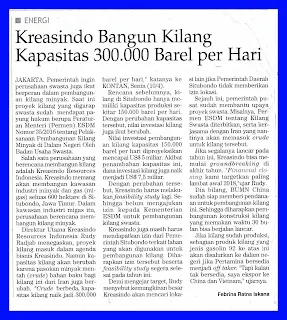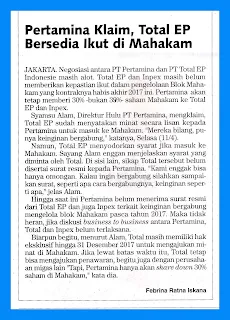PT Perusahaan Gas Negara (Persero) Tbk (PGN) this year get an extra supply of natural gas to East Java region of Husky CNOOC Madura Limited (HCML). This makes the supply of gas to PGN customers more reliable.
PGN Commercial Director Danny Praditya said gas supplies from HCML started flowing in May 2017 with the volume distributed in stages from 20 million cubic feet per day (MMSCFD) to more than 100 MMSCPD. Increased supply of HCML to do as the level of market needs natural gas in East Java.
HCML gas supply comes from BD field and will be distributed from the handover point from Semare stations to the existing pipeline network PGN in Pasuruan. "The gas supply from HCML will last for 20 years, so the supply of gas to PGN customers ranging from Surabaya in East Java, Gresik, Sidoarjo, Pasuruan, Mojokerto until more reliable," says Danny.
Danny said, with the reliability of energy supplies of natural gas, will encourage more investors are interested and like to invest in East Java. Which is expected to drive economic growth into a better society.
"With the reliability of energy supplies PGN gas, it will make investors happy to invest in East Java," says Danny. He added that the reliability of natural gas supply to customers to be one of the main focus PGN. To materialize the right reliability of PGN has a PGN program 360 ° Integrated Solution.
With a 360 ° program Integrated Solution PGN, PGN ensure and resolve all problems related to the utilization of natural gas customers. "In PGN 360 ° Integrated Solution for instance in terms of gas supply, PGN is not just rely on one source of the gas field, with a network infrastructure integrated gas pipeline, the gas supply can be obtained from various natural gas field.
PGN also has a fleet of CNG to the trucking LNG to supply natural gas in regions unreached PGN gas pipeline, "said Danny.
Vice President Corporate Communications PGN, Irwan Andri Atmanto added, increasingly tough line PGN gas supply in East Java, PGN also aggressively promoting natural gas infrastructure in the region. One example, PGN is currently building a natural gas distribution pipeline segment-Lamongan Gresik-Tuban along the 141 kilometer (km).
"It has been PGN's commitment to continue to open the area of natural gas users new territory, so that the use of domestic natural gas production is increasing," said Irwan.
PGN currently has 1,652 supply natural gas to large industrial and power plants, 1,929 commercial customers (hotels, restaurants, hospitals) and small and medium enterprises (SMEs), and 204,000 household customers. PGN customers scattered in various areas ranging from North Sumatra, Islands, Riau, South Sumatra, Lampung, Jakarta, West Java, Banten, Central Java, East Java, North Borneo and Papua Sorong.
Lodging in East Java region, serving 27 170 PGN household customers, 209 commercial customers and 475 industrial customers. "Gas pipeline built and operated PGN currently more than 7,200 km, equivalent to 80 percent of the pipeline gas downstream throughout Indonesia.
In addition to the gas pipeline, PGN also operates two Floating Storage Regasification Unit (PSRU), 11 SPBGs, and 5 mobile refueling unit (MRU). the cost of gas infrastructure development is done PGN without relying on the state budget, "concluded lrwan.
IN INDONESIAN
Dipasok Gas Husky, PGN Semakin Handal
PT Perusahaan Gas Negara (Persero) Tbk (PGN) tahun ini mendapatkan tambahan pasokan gas bumi untuk wilayah Jatim dari Husky CNOOC Madura Limited (HCML). Hal ini membuat pasokan gas ke pelanggan PGN semakin handal.
Direktur Komersial PGN Danny Praditya mengungkapkan, pasokan gas dari HCML mulai mengalir pada Mei 2017 dengan volume yang disalurkan secara bertahap mulai 20 juta kaki kubik per hari (MMSCFD) hingga lebih dari 100 MMSCFD. Peningkatan pasokan dari HCML dapat dilakukan seiring tingkat kebutuhan pasar gas bumi di Jatim.
Pasokan gas HCML berasal dari lapangan BD dan akan disalurkan dari titik serah dari Stasiun Semare ke jaringan pipa eksisting PGN di Pasuruan. “Pasokan gas dari HCML akan berlangsung selama 20 tahun, sehingga pasokan gas untuk pelanggan PGN di Jatim mulai dari Surabaya, Gresik, Sidoarjo, Mojokerto hingga Pasuruan semakin handal," kata Danny.
Danny mengatakan, dengan kehandalan pasokan energi gas bumi tersebut, akan mendorong investor makin berminat dan betah berinvestasi di Jatim. Sehingga diharapkan akan mendorong pertumbuhan ekonomi masyarakat menjadi lebih baik.
"Dengan kehandalan pasokan energi gas bumi PGN, tentu akan membuat investor senang berinvestasi di Jatim," ujar Danny. la menambahkan, keandalan pasokan gas bumi ke pelanggan menjadi salah satu fokus utama PGN. Untuk mewujud kan kehandalan pasokan tersebut PGN memiliki program PGN 360° Integrated Solution.
Dengan program PGN 360° Integrated Solution, PGN memastikan dan menyelesaikan seluruh permasalahan pelanggan terkait pemanfaatan gas bumi. "Dalam PGN 360° Integrated Solution misalnya dalam hal pasokan gas, PGN tidak hanya bergantung pada satu sumber lapangan gas, dengan jaringan infrastruktur pipa gas yang terintegrasi, pasokan gas bisa didapat dari berbagai lapangan gas bumi.
PGN juga memiliki armada CNG hingga LNG trucking yang dapat mensuplai gas bumi di wilayah yang belum terjangkau pipa gas bumi PGN," kata Danny.
Vice President Corporate Communication PGN, Irwan Andri Atmanto menambahkan, sejalan makin tangguhnya pasokan gas bumi PGN di jawa Timur, PGN juga semakin agresif mengembangkan infrastruktur gas bumi di wilayah tersebut. Salah satu contohnya, PGN saat ini sedang membangun pipa distribusi gas bumi ruas Gresik-Lamongan-Tuban sepanjang 141 kilometer (km).
"Telah menjadi komitmen PGN untuk terus membuka wilayah wilayah pengguna gas bumi baru, sehingga pemanfaatan produksi gas bumi dalam negeri semakin meningkat," ujar Irwan.
Saat ini PGN telah memasok gas bumi ke 1.652 industri besar dan pembangkit listrik, 1.929 pelanggan komersial (hotel, restoran, rumah sakit) dan usaha kecil menengah (UKM), dan 204.000 pelanggan rumah tangga. Pelanggan PGN tersebar di berbagai wilayah mulai dari Sumatera Utara, Kepulauan, Riau, Sumatera Selatan, Lampung, DKI Jakarta, Jawa Barat, Banten, jawa Tengah, jawa Timur, Kalimantan Utara dan Sorong Papua.
Khusus di wilayah Jatim, PGN melayani 27.170 pelanggan rumah tangga, 209 pelanggan komersial, dan 475 pelanggan industri. "Pipa gas yang dibangun dan dioperasikan PGN saat ini lebih dari 7.200 km, ini setara dengan 80 persen pipa gas bumi hilir seluruh Indonesia.
Selain pipa gas, PGN juga mengoperasikan dua Floating Storage Regasification Unit (PSRU), 11 SPBG, dan 5 mobile refueling unit (MRU). Biaya pembangunan infrastruktur gas tersebut dilakukan PGN tanpa mengandalkan APBN," tutup lrwan.
Harian Bangsa, Page-4, Saturday, April, 15, 2017








